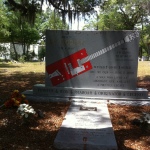Jerry Maren, the last Munchkin from the Wizard of Oz, died May 24, 2018 at the age of 98 in Los Angeles.
Jerry was one of the Lollipop Kids. Both photos are from the Los Angeles Times.
http://www.latimes.com/local/obituaries/la-me-jerry-maren-20180606-story.html
In 2014, I wrote a blog post about Meinhardt Rabe, another Munchkin, one with a Florida connection. I’ve reposted it here.
End of the Yellow Brick Road
On April 9, 2010, Mienhardt Raabe, one of the last surviving Munchkins from The Wizard of Oz died at the age of 94 after his heart stopped as “averred by a local coroner”, according to a clever Wikipedia writer.
Why clever? Because Raabe who played a Munchkin coroner in the classic film’s fantasy Emerald City, had one uncredited 13-second line concerning the death of the Wicked Witch of the East:
“As a coroner I must aver
I thoroughly examined her
And she’s not only merely dead
She’s really, most sincerely dead.”
My bet is that the irony would not have been lost on Raabe. As a youth, he did not believe there were other small people until he visited the Midget Village at Chicago’s Century of Progress in 1933. Raabe, who was about 42 inches tall, worked for many years as a spokesman for the giant meat products (read hot dogs) company Oscar Mayer where he was known as “Little Oscar, the World’s Smallest Chef.” Raabe drove the first Wienermobile, an idea attributed to Carl Mayer, the company founder’s nephew.
But Raabe was bigger than just using his size for entertainment and to make a living. He had an accounting degree and an MBA. He served as a pilot in the Civil Air Patrol during World War II, and was married for 50 years to a woman his height who died in a car accident in 1997.
Raabe’s version of the Oz Yellow Brick Road ended at Penney Farms, a North Florida retirement community dating back to 1926 when J.C. Penney for department store fame planned to develop a village for experimental farming. The town was incorporated in 1927 and the stock market crash of 1929 caused Penney to scale back his plans. Plan B for the magnate was retirement community for retired ministers. Today the 192- acre retirement community houses Christian laypeople as well as clergy.
It’s an old Florida story—built during the boom just before the crash—and it’s an old Florida scene driving along state road 16 south of Jacksonville and heading west from St. Augustine. The dark green shade from the trees lining the road sets off the oranges and earth tones of the one-story concrete block homes. The white glare reflected from piles of limestone gravel on the north side of 16 makes the country road look dark, cool and ancient. It is a palette that colored 1950s Florida: green trees surrounding jalousied porches. The orange colors of the old buildings offer a warm counterpoint to the cool shade. The scene might fit nicely into a gray scale rendering for the black-and-white Kansas scene in the Wizard of Oz although the leafy North Florida setting is its own version of an Emerald City.
One Florida obituary, sadly, led to another and I found one for another Munchkin Karl Slover, who played a trumpeter in The Wizard of Oz. He was born in what is now the Czech Republic. At eight years old, he was about two feet tall eventually growing to four feet five inches. His six and a half foot father buried Karl in the backyard up to his neck, subjected him to limb stretching exercises to promote growth and eventually sold him to a group called the Singing Midgets. After Oz, Slover spent later years training dogs to play the piano and toured a Children’s birthday party circuit with his musical dogs, according to an online Tampa Bay Time obituary. Slover, who lived in St. Petersburg, Florida, died November 15, 2011.
Raabe, Slover and Penney Farms are just three back roads stories that connect to larger worlds and different times. Most of my facts are from Wikipedia and the Tampa Bay Times online newspaper. Quick looks—and even small stories—are a little like the first viewing of The Wizard of Oz, the film that focused a generation’s dreams. These glimpses can pave the way (like the Yellow Brick Road?) to closer looks and deeper perceptions of unusual lives.
Posted by Anne Bellissimo 2014
The Wizard of Oz (1939) was a grand colorful story that showcased the dreams of Depression babies complete with a golden road that led out of the forest, through a poppy-strewn field and to a castle. The dark side of the story is represented by mythic witches representing the cardinal directions and the hypocrisy of the Wizard who consolidated power through audio/visual aids. The Wizard of Oz came out the same year as Marjorie Kinnan Rawlings’ The Yearling . Both used childhood to look backward into America’s rural past and illustrated coming-of-age with the “No place like Home” sentiment. Jody, the young protagonist in The Yearling, ended his youth with a gun shot that killed a pet deer that was eating family crops. Dorthy in Oz had to kill a witch (and then click her ruby slippers) to get home again. Both illustrated different aspects of the American Dream that I believe are still with us today.








Leave a Reply